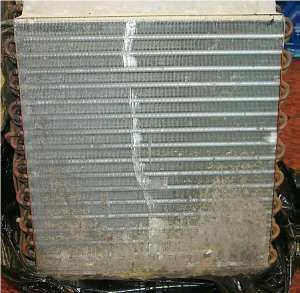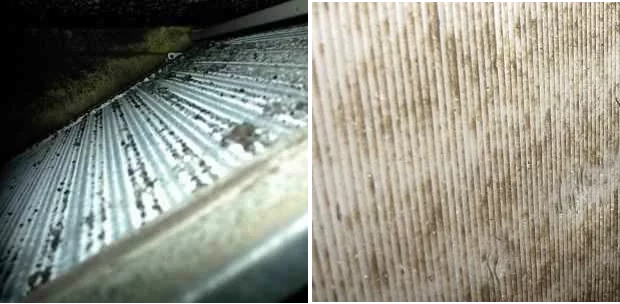Introduction
Air conditioning is responsible for substantial electricity consumption and peak demand in most of the United States. Over the past decade, energy conservation researchers have studied air conditioning more and more. Much of this research has focused on the impact of air flow, duct leakage, and refrigerant charge level on cooling performance.
One area, which has been neglected by researchers, is fouling of evaporator and formicary corrosion. Known commonly as ant’s nest corrosion, champagne leaks, or just simply as formicary, the issue presents as a hard to detect leak within the fin pack of an evaporator coil. This tiny leak or set of leaks results in loss of system refrigerant over time. While the incidence of formicary corrosion is low nationwide, it is more prevalent in warm, humid climates found in southern portions of the United States where slimy biofilms coat the coil fins.
The tunneling action that leads to corrosion is caused by the presence of organic acids mixed with moisture on the copper tube within the fin pack. Two common acids known to cause formicary corrosion are formic and acetic acids. Certain manufacturing oils and lubricants can contain compounds that form these organic acids, but common household items can also breakdown to form formic and acetic acids. These can include building materials like formaldehyde adhesives, foam insulation, and laminates, as well as personal hygiene products like cosmetics, disinfectants, deodorizers, and cleaning solvents. To initiate corrosion, the presence of water is necessary. The corrosion rate is aggravated by the presence of mold biofilm that keeps the fins wet.
Every technician will tell you that every time they look at these coils, they are dirty with mold biofilm. A standard part of routine A/C maintenance and residential commissioning is to clean the evaporator coil with a wire brush and detergent or other cleaning chemistry, and to clean the outdoor coil of leaves and other debris. Over the last 20 years, the simple use of appropriate germicidal UV light can prevent this and keep the coil clean and free of any biofilm buildup.
The presence of mold biofilm on cooling coil acts like a water sponge that keeps the fins constantly wet and sticky, which capture and retain particulates and chemical contaminants, thus enhancing the formic acid corrosion rate. When the biofilm is eliminated with an efficient germicidal UV system, the coil is not permanently wet, does not trap and retains as much contaminants, and consequently its corrosion rate is greatly reduced.

Buildup of mold biofilm in lower right hand corner completely blocks air flow
Coils normally foul due to bioaerosols and other biologically active materials, which are ubiquitous in hot climates. This usually also lead to significant indoor air quality problems that can trigger respiratory allergic responses of building occupants.

Fungal biofilm growth on a residential (Left) and commercial (Right) cooling coil
The biofilm that causes evaporator fouling and its accelerated corrosion also impacts on the cooling performance and energy efficiency. Large commercial heating and cooling coils have the same problems and are prone to the same type of fouling and consequential corrosion issues. Their lifespan can also be increased notably by using an appropriate UV germicidal system that prevents mold buildup in hot and humid climate.
The first step to take to reduce the formicary corrosion due is to prevent the formation of a biofilm of molds and fungi with an adequate germicidal UV system. Biofilm-free fins will be less susceptible to retain dusts and potentially corrosive compounds, as well as the moisture that activates the corrosion effect.
References
Siegel, Jeffrey, I. Walker & M. Sherman. 2002. “Dirty Air Conditioners: Energy Implications of Coil Fouling” Submitted to the 2002 ACEEE Summer Study on Energy Efficiency in Buildings.
Siegel, Jeffrey A. and W.W. Nazaroff. 2002. “Modeling Particle Deposition on HVAC Heat Exchangers.” Submitted to the Indoor Air 2002 conference.
Siegel, Jeffrey and I.S. Walker. 2001. “Deposition of Biological Aerosols on HVAC Heat Exchangers.”